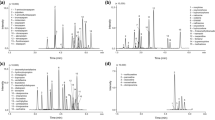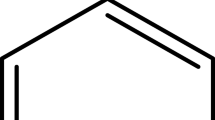Abstract
Carbamazepine (CBZ) and oxcarbazepine (OX) are highly effective anti-psychotic drugs. In USP, it is stated that CBZ has several impurities including, iminodibenzyl (IDB), iminostilbene (IMS), and 9-methylacridine (MA). While, for OX, it is reported to have impurities like, CBZ, IMS and 9-methylacridine (MA). Presence of such impurities in various forms may reduce the efficacy and increase the side effects. It is declared that CBZ (Tegretol®) and OX (Trileptal®) oral suspensions contain methylparaben, propylparaben, and sorbic acid as preservatives. For the first time, CBZ and OX were determined with their impurities and formulation excipients with a highly selective and sensitive ecofriendly LC/MS/MS method using methanol: water containing 0.1% formic acid (95:5, v/v) as a mobile phase. Mass spectrometric quantitation was carried out in positive and negative ion modes. Application of the proposed method to quantify CBZ and OX in their tablets and oral suspensions was successfully done. The results obtained by the suggested method and the reported methods for both drugs agreed well with each other. The developed method has the advantage of being ecofriendly using the simple green mobile phase. Unlike other published methods, it is successfully applied to quantify the impurities and excipients along with parent drugs within limits recommended by USP guidelines.
Graphical Abstract







Similar content being viewed by others
Change history
29 October 2018
The original version of this article unfortunately contained a mistake.
References
Trišović NP, Božić B, Petrović SD, Tadić SJ, Avramov Ivić ML (2014) Electrochemical characterization and determination of carbamazepine as pharmaceutical standard and tablet content on gold electrode. Hem Ind 68:207–212
”The British Pharmacopoeia” (2007) Her Majesty’s. The Stationary Office, London
”The United States Pharmacopeia” (2012) National Formulary 35, United States Pharmacopeia Convention Inc., 30th Ed
Mowafy HA, Alanazi FK, El Maghraby GM (2012) Development and validation of an HPLC–UV method for the quantification of carbamazepine in rabbit plasma. Saudi Pharm J 20:29–34
Rodina TA et al. (2016) Rapid HPLC/MS/MS for determination of carbamazepine and carbamazepine-10,11-epoxide. Pharm Chem J 50:52–56
Oh EK, Ban E, Woo JS, Kim CK (2006) Analysis of carbamazepine and its active metabolite, carbamazepine-10,11-epoxide in human plasma using high-performance liquid chromatography. Anal Bioanal Chem 386:1931–1936
Elizabeth GS, Darla RL, Mohamed AV, Matthew DK (2007) Simultaneous determination of lamotrigine, zonisamide, and carbamazepine in human plasma by high-performance liquid chromatography. Biomed Chromatogr 21:225–228
Budakova L, Brozmanova H, Grundmann M, Fischer J (2008) Simultaneous determination of antiepileptic drugs and their two active metabolites by HPLC. J Sep Sci 31:1–8
Yoshida T, Imai K, Motohashi S, Hamano S, Sato M (2006) Simultaneous determination of zonisamide, carbamazepine, carbamazepine-10,11-epoxide in infant serum by high-performance liquid chromatography. J Pharm Biomed Anal 41:1386–1390
Mennickent S, Fierro R, Vega M, de Diego M, Godoy CG (2009) Instrumental planar chromatographic method for determination of carbamazepine in human serum. J Sep Sci 32:1454–1458
Kadioglu Y, Demirkaya F (2007) Determination of carbamazepine in pharmaceutical dosage form using GC-FID. Chromatographia 66:169–172
Tatar US (2006) Determination of carbamazepine in pharmaceutical preparations using high-performance liquid chromatography and derivative spectrophotometry. Turkish J Pharm Sci 3:123–139
Patel RB, Patel MR, Bhatt KK, Patel BG (2011) Development and validation of HPTLC method for estimation of carbamazepine in its formulations and in vitro release study. Chromatogr Res Int 2011:1–8
Aydoğmuş Z, Yılmaz EM, Aslan SS, Taş ZE, Üner M (2016) RP-HPLC method for the simultaneous determination of carbamazepine and nilotinib: application to solubility studies. Pharm Chem J 3:1–10
Sultana N, Arayne MS, Ali SN (2013) An ultra-sensitive LC method for the simultaneous determination of paracetamol, carbamazepine, losartan and ciprofloxacin in bulk drug, pharmaceutical formulation and human serum by programming the detector. American J Anal Chem 4:24–33
Dzodić PLJ, Zivanović LJ, Protić AD, Zećević ML, Jocić BM (2010) Determination of carbamazepine and its impurities iminostilbene and iminodibenzyl in solid dosage form by column high-performance liquid chromatography. J AOAC Int 93:1059–1068
Kumar A, Gupta A, Kumar P, Agarwal AK (2016) Method for optimizing HPLC for separating carbamazepine and its impurities. Int J Res App Nat Soc Sci (IMPACT: IJRANS) 4:63–68
Dzˇodic´ P, Zˇivanovic´ L, Protic A, Zecˇevic´ M, Jocic´ B (2009) Chemometrically assisted development and validation of LC for simultaneous determination of carbamazepine and its impurities iminostilbene and iminodibenzyl in solid dosage form. Chromatographia 70:1343–1351
Reddy KS, Naidu NVS (2015) Development and validation of HPLC method for determination of oxcarbazepine in bulk and pharmaceutical formulation. Anal Chem Indian J 15:243–250
Bhaumik U et al. (2010) Stability-indicating HPLC method for the determination of oxcarbazepine in pharmaceutical formulation drug and pharmaceutical formulations. Asian J Chem 22:2051–2057
Žirojević J, Drljevic-Đurić K, Đurđević A (2014) Determination of oxcarbazepine and its related substances using UHPLC method with UV detection. Arh Farm 64:83–94
Reddy PS, Babu KS, Kumar N (2014) Development and validation of a stability-indicating RP-LC method for the estimation of process-related impurities and degradation products of oxcarbazepine in pharmaceutical formulation. Acta Chromatogr 2:267–282
Pathare DB, Jadhav AS, Shingare MS (2007) Validated stability indicating LC method for oxcarbazepine. J Pharm Biomed Anal 43:1825–1830
Dwivedi P, Yadav S, Rao J (2016) Validated RP HPLC method for the determination of related substance of oxcarbazepine an antiepileptic drugs. Int J PharmTech Res 9:444–451
Through web site: https://www.indiamart.com/frolic-pharmachem/oxcarbazepine-impurities.html. Access 23/9/2017, 21:00 PM
Juenke JM, Brown PI, Urry FM, McMillin GA (2006) Drug monitoring and toxicology: a procedure for the monitoring of oxcarbazepine metabolite by HPLC UV. J Chromatogr Sci 44:45–48
Saracino MA, Tallarico K, Raggi MA (2010) Liquid chromatographic analysis of oxcarbazepine and its metabolites in plasma and saliva after a novel micro extraction by packed sorbent procedure. Anal Chim Acta 661:222–228
Kimiskidis V et al. (2007) Development and validation of a high performance liquid chromatographic method for the determination of oxcarbazepine and its main metabolites in human plasma and cerebrospinal fluid and its application to pharmacokinetic study. J Pharm Biomed Anal 43:763–768
Srinubabu G, Ratnam BV, Rao AA, Rao MN (2008) Development and validation of LC/MS/MS method for the quantification of oxcarbazepine in human plasma using an experimental design. Chem Pharm Bull 56:28–33
Kashif UH, Kumar N (2014) Development and validation of LC/MS/MS method for the simultaneous quantitative analysis of oxcarbazepine and its metabolite 10-hydroxycarbazepine in K2EDTA plasma. Int J Pharm Pharm Sci 6:422–429
Greiner-Sosanko E, Giannoutsos S, Lower DR, Virji MA, Krasowski MD (2007) Drug monitoring simultaneous analysis of lamotrigine, oxcarbazepine, 10- hydroxycarbazepine and zonisamide by HPLC-UV and a rapid GC method using a nitrogen-phosphorus detector for levetiracetum. J Chromatogr Sci 45:616–622
Kundu S, Gyadangi B (2013) A simple, validated, single HPLC method for the determination of assay, dissolution, related substance of an antiepileptic drug in different pharmaceutical dosage form. Indo Am J Pharm Res 3:1722–1732
Reddy TS, Devi PS (2007) Validation of a high performance thin layer chromatographic method with densitometric detection for quantitative analysis of two anticonvulsants in tablets. J Planar Chromatogr Modern TLC 20:451–456
Rao KS, Belorkar N, Rao MEB (2009) Development and validation of stability indicating liquid chromatographic method for the quantitative determination of oxcarbazepine in tablet dosage forms. Pharm Anal J Young Pharm 1:270–277
Raghavi K, Sindhura M, Prashanthi R, Nalluri BN (2012) Studies on forced degradation of oxcarbazepine using LC-MS compatible stability indicating RP-HPLC method. J Chem Pharm Res 4:3885–3893
Bhoite DS, Dhole SN, Bhoir S, Sangole P, Thorat S (2013) Development and validation of stability indicating HPTLC method for determination of oxcarbazepine in bulk and pharmaceutical formulation. Int J Pharm Pharm Sci 5:127–132
Fortuna A, Sousa J, Alves G, Falcão A, Soares-da-Silva P (2010) Development and validation of an HPLC-UV method for the simultaneous quantification of carbamazepine, oxcarbazepine, eslicarbazepine acetate and their main metabolites in human plasma. Anal Bioanal Chem 397:1605–1615
Franceschi L, Furlanut M (2005) A simple method to monitor plasma concentration of oxcarbamazepine, carbamazepine, their main metabolites and lamotrignine in epileptic patients. Pharmacol Res 51:297–302
Bugamelli F, Sabbioni C, Mandrioli R, Kenndler E, Albani F, Raggi MA (2002) Simultaneous analysis of six antiepileptic drugs and two selected metabolites in human plasma by liquid chromatography after solid-phase extraction. Anal Chim Acta 472:1–10
Breton H, Cociglio M, Bressolle F, Peyriere H, Blayac JP, Hillaire-Buys D, Liquid chromatography-electrospray mass spectrometry determination of carbamazepine, oxcarbazepine and eight of their metabolites in human plasma. J Chromatogr B Anal Technol Biomed Life Sci 828: 80–90
Deeb S, McKeown DA, Torrance HJ, Wylie FM, Logan BK, Scott KS (2014) Simultaneous analysis of 22 antiepileptic drugs in postmortem blood, serum and plasma using LC/MS/MS with a focus on their role in forensic cases. J Anal Toxicol 38:485–494
Yin L et al. (2016) Simultaneous determination of ten antiepileptic drugs in human plasma by liquid chromatography and tandem mass spectrometry with positive/negative ion-switching electrospray ionization and its application in therapeutic drug monitoring. J Sep Sci 9:964–972
Wang L et al. (2016) Simultaneous determination of topiramate, carbamazepine, oxcarbazepine and its major metabolite in human plasma by SFC/ESI/MS/MS with polarity switching: application to therapeutic drug monitoring. Arab J Chem. https://doi.org/10.1016/j.arabjc.2016.09.016
Levert H, Odou P, Robert H (2002) Simultaneous determination of four anti-epileptic drugs in serum by high performance liquid chromatography. Biomed Chromatogr 16:19–24
Rowe RC, Sheskey PJ, Owen SC (2006) Handbook of pharmaceutical excipients. 5th ed., Pharmaceutical Press and American Pharmacists Association
Singh S et al. (2012) A critical review on the use of modern sophisticated hyphenated tools in the characterization of impurities and degradation products. J Pharm Biomed Anal 69:148–173
Emergency Planning and Community Right-to-Know Act (2004) Section 313; Toxic Release Inventory (TRI)
Author information
Authors and Affiliations
Contributions
Both Dr. MMA and Dr. NSA did the practical work and wrote the manuscript.
Corresponding author
Ethics declarations
Conflict of interest
Authors A declares that she has no conflict of interest. Authors B declares that she has no conflict of interest.
Research involving human participants and/or animals
No human volunteers or animals were used in this work.
Rights and permissions
About this article
Cite this article
Abdelrahman, M.M., Abdelwahab, N.S. Analysis of Carbamazepine, Oxcarbazepine, Their Impurities, and Non-Labeled Interfering Substances by Stability-indicating UPLC/MS/MS Method: Studying the Method’s Greenness Profile. Chromatographia 81, 1503–1517 (2018). https://doi.org/10.1007/s10337-018-3623-0
Received:
Revised:
Accepted:
Published:
Issue Date:
DOI: https://doi.org/10.1007/s10337-018-3623-0




